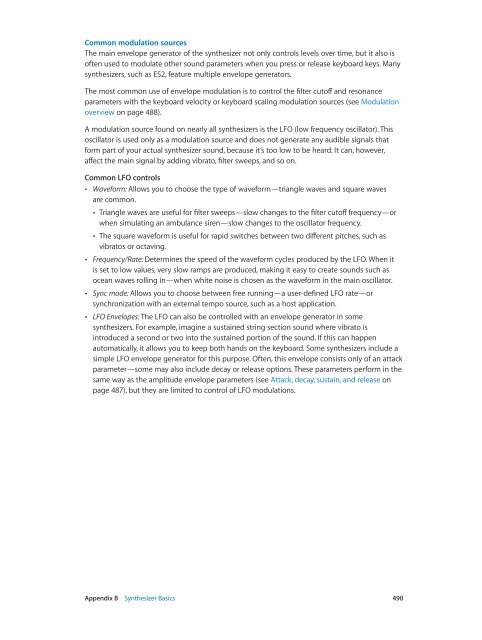Apple MainStage 3 Instruments - MainStage 3 Instruments
Apple MainStage 3 Instruments - MainStage 3 Instruments
Apple MainStage 3 Instruments - MainStage 3 Instruments
Create successful ePaper yourself
Turn your PDF publications into a flip-book with our unique Google optimized e-Paper software.
Common modulation sources<br />
The main envelope generator of the synthesizer not only controls levels over time, but it also is<br />
often used to modulate other sound parameters when you press or release keyboard keys. Many<br />
synthesizers, such as ES2, feature multiple envelope generators.<br />
The most common use of envelope modulation is to control the filter cutoff and resonance<br />
parameters with the keyboard velocity or keyboard scaling modulation sources (see Modulation<br />
overview on page 488).<br />
A modulation source found on nearly all synthesizers is the LFO (low frequency oscillator). This<br />
oscillator is used only as a modulation source and does not generate any audible signals that<br />
form part of your actual synthesizer sound, because it’s too low to be heard. It can, however,<br />
affect the main signal by adding vibrato, filter sweeps, and so on.<br />
Common LFO controls<br />
••<br />
Waveform: Allows you to choose the type of waveform—triangle waves and square waves<br />
are common.<br />
••<br />
Triangle waves are useful for filter sweeps—slow changes to the filter cutoff frequency—or<br />
when simulating an ambulance siren—slow changes to the oscillator frequency.<br />
••<br />
The square waveform is useful for rapid switches between two different pitches, such as<br />
vibratos or octaving.<br />
••<br />
Frequency/Rate: Determines the speed of the waveform cycles produced by the LFO. When it<br />
is set to low values, very slow ramps are produced, making it easy to create sounds such as<br />
ocean waves rolling in—when white noise is chosen as the waveform in the main oscillator.<br />
••<br />
Sync mode: Allows you to choose between free running—a user-defined LFO rate—or<br />
synchronization with an external tempo source, such as a host application.<br />
••<br />
LFO Envelopes: The LFO can also be controlled with an envelope generator in some<br />
synthesizers. For example, imagine a sustained string section sound where vibrato is<br />
introduced a second or two into the sustained portion of the sound. If this can happen<br />
automatically, it allows you to keep both hands on the keyboard. Some synthesizers include a<br />
simple LFO envelope generator for this purpose. Often, this envelope consists only of an attack<br />
parameter—some may also include decay or release options. These parameters perform in the<br />
same way as the amplitude envelope parameters (see Attack, decay, sustain, and release on<br />
page 487), but they are limited to control of LFO modulations.<br />
Appendix B Synthesizer Basics 490
















